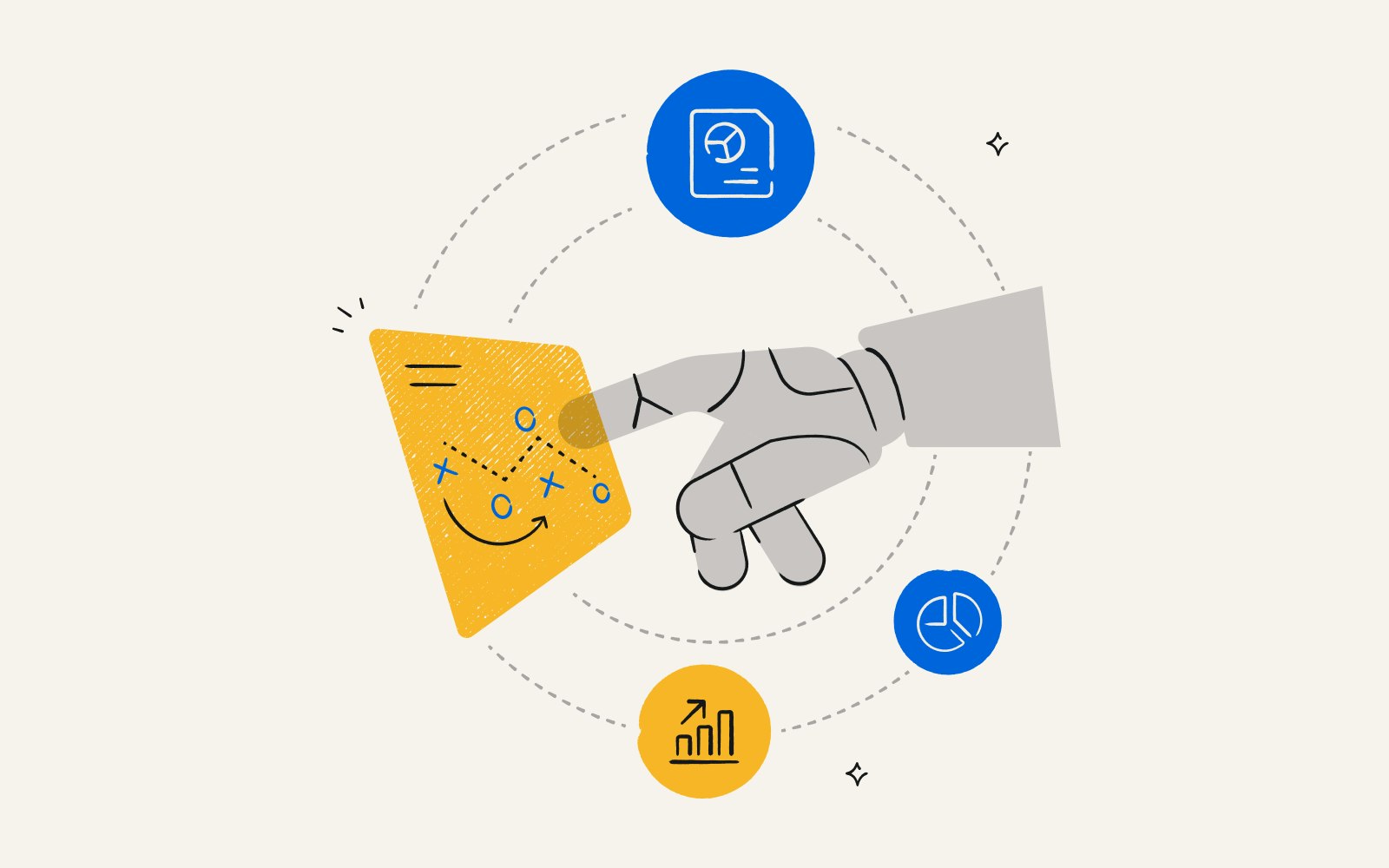Humans + machines: Designing hybrid qualitative studies that surface emotion faster
By Andrew Littlefield●7 min. read●Sep 11, 2025

For qualitative studies, speed has always been a problem. Coding responses, interpreting nuance, and applying context seem like deeply human tasks that resist shortcuts. But large language models are rewriting the rules.
Researchers are using AI not to do their jobs for them, but rather to do their jobs faster. AI tools can help free up time, stretch budgets, and uncover insights that once took entire teams to find. And really, wouldn’t you rather be at the beach on a summer Friday than buried in a market research report?
The question isn’t if humans and machines should work together, it’s how to combine the two into a research powerhouse that can surface emotional insight at scale. Let’s dive in.
What is hybrid qualitative research? The new approach to emotion detection
Hybrid qualitative research is the practice of combining AI-powered analysis (such as natural language processing, sentiment scoring, and pattern recognition) with the expertise of a human moderator or researcher. In this approach, the machine handles the heavy lifting at lightning speed, while you focus on interpreting nuance, context, and emotion.
As a comparison, think about the movie “Aliens” when Ripley squares off against the xenomorph in a hydraulic power loader. All movie long, the superpowered aliens have been tossing humans around like rag dolls. But once Ripley straps into that mechanical suit, she levels the playing field. She’s suddenly stronger, faster, and more capable than she could ever be on her own.
Similarly, blending AI speed with human interpretation creates a hybrid model that can overcome the classic “scale versus depth” trade-off.
AI’s impact on qualitative research
AI can process large volumes of qualitative data in seconds, surfacing patterns and emotional markers that humans can then explore in greater detail. This preserves the richness of qualitative insight while removing the bottlenecks of manual-only analysis.
A well-designed hybrid qualitative study typically includes several components:
AI tools handle preprocessing tasks like transcribing, translating, and coding open-ended responses.
Automated sentiment and emotion analysis quickly highlights recurring themes and emotional triggers.
Human researchers then bring context and empathy to the findings, refining interpretations and identifying next steps.
Finally, iterative feedback loops allow both the AI and the human to adapt as new insights emerge.
In other words, you bring the strategy and empathy, the machine brings the muscle. Together, you can take on even the most complex emotional insights at scale.
Hybrid qualitative research vs. traditional methods: key differences
Hybrid qualitative research studies differ from traditional methods in a few critical ways. The combination of AI speed and human expertise creates a research process that’s faster, more scalable, and often more accurate than human-only approaches.
A 2024 Greenbook study found that over 75% of market research professionals were either already using or plan to use generative AI for tasks like:
1. Analyzing or summarizing text, images, or video
2. Managing knowledge across multiple sources
3. Automating research design or execution
4. Summarizing meetings
By pairing machine efficiency with human understanding, hybrid approaches give you the depth of traditional qualitative methods without the bottlenecks that slow projects down.
Benefits of hybrid qualitative research for market researchers
If you’re not already using hybrid qualitative research methods for your market research, you’re at risk of falling behind. A 2024 study from User Interviews found that 56% of researchers are already using AI for qualitative analysis, an increase from just 20% in 2023.
AI research tool providers like Looppanel claim to make qualitative research much faster through processes like AI transcripts and response analysis.
By automating some heavy lift tasks with AI, market researchers benefit from:
The ability to process larger sample sizes: Analyze data from hundreds or even thousands of participants without sacrificing the richness or nuance of qualitative insights.
Reduced fatigue and bias: Offload repetitive coding tasks to AI, freeing researchers to focus on interpretation and reducing the influence of exhaustion or personal bias on findings.
More consistent emotion coding across studies: Apply uniform, AI-assisted coding frameworks that keep emotional analysis consistent from one study to the next.
Higher ROI on research investments: Deliver insights faster, at a lower cost, while maintaining depth and accuracy. This maximizes the return on every research dollar spent.
Some AI research tools go beyond crunching data and take the people wrangling off your plate. In User Interviews’ 2024 survey, a third of market research professionals said they spend 4-10 hours a week managing other researchers rather than analyzing data or presenting insights to leadership. By automating parts of that coordination, AI removes unnecessary overhead, making research cheaper, faster, and more accessible to smaller teams and budgets.
How to design hybrid qualitative studies for emotion analysis
Designing a hybrid qualitative study means thinking about the human and machine components from the very beginning. Here are some best practices for setting yourself up for emotional insight at scale:
Structure questions for dual analysis (AI + human)
Plugging your traditional interview questions into a hybrid model will lead to frustration — you need a new approach. Write your interview or survey questions so they work for both automated and human review. That means using open-ended prompts rich enough for qualitative depth, but clear enough for AI to code accurately.
Choose multi-modal data collection methods
Emotions often show up differently in text, voice, and video. Combining multiple formats — written responses, voice recordings, and video interviews — gives both the AI and the human moderator more context. Tone of voice, facial expressions, and pauses can all signal emotional nuance that text alone might miss.
Set up AI tools for initial pattern recognition
Before any human review, run your data through AI to identify recurring themes, sentiment trends, and possible emotional triggers. This first pass speeds up the process, flags anomalies, and surfaces patterns you might not have spotted manually. It’s like giving yourself the Cliff Notes version before you dive into reading the full text.
Design human moderator intervention points
Plan when and how human researchers will step in, whether to probe deeper during live sessions, validate AI-flagged themes, or add cultural and contextual understanding to the analysis.
Of course, hybrid models still rely on the skill and nuance a seasoned proctor develops over their career to uncover authentic emotional responses:
Build trust early so participants feel safe sharing genuine thoughts.
Ask follow-up questions that encourage elaboration without leading the respondent.
Minimize researcher presence or cues that could bias answers.
Randomize question order to avoid predictable patterns that influence responses.
When possible, capture reactions in-the-moment rather than in retrospective formats.
AI tools for qualitative research: essential technology stack
Choosing the right AI tool depends on what part of the qualitative process you want to speed up, scale, or enhance. Below is a breakdown of notable options by function.
Sentiment analysis (text and voice)
IBM Watson: Cloud-based natural language processor service that analyzes text for sentiment and detects emotions, helping researchers gauge tone in open-ended feedback.
Lexalytics: Text analytics platform that turns unstructured text into insights by extracting sentiment, themes, and entities.
Emotion detection (video interviews)
Affectiva: Facial coding software that recognizes expressions frame-by-frame and infers emotions like joy, anger, or surprise from video recordings.
Microsoft Azure Face API: Computer-vision service that detects faces and quantifies emotional states in images or live video streams.
Real-time transcription and coding
Otter.ai: AI transcription service that records and transcribes interviews live, with speaker labels and summaries.
Looppanel: An AI-powered platform that delivers accurate transcripts in minutes and auto-tags key themes, producing summaries and insights in real time.
Workflow integrations
Zapier: No-code platform connecting thousands of apps, from survey tools to CRMs, to automate data flow and reporting.
Workato: Enterprise integration (iPaaS) platform that links AI tools, databases, and collaboration systems into a cohesive workflow.
Hybrid qualitative research platforms
Recollective: Online community and focus group platform combining live and asynchronous activities, with AI that analyzes rich qualitative inputs for quick insights.
Forsta: End-to-end research suite supporting mobile ethnography, online journals, and live-streamed focus groups, all with real-time analysis capabilities.
Common challenges and solutions in hybrid qualitative studies
Adopting any new model comes with growing pains. Here are a few common challenges in hybrid qualitative research, and how to get ahead of them:
Challenge: AI missing cultural context
Large language models pull from vast, but imperfect, training data. They may miss cultural cues or fail to grasp the nuances of a specific niche, whether it’s an industry jargon, a regional phrase, or the norms of a specialized career field.
Solution: Build in human validation checkpoints
Human researchers can spot and interpret these subtleties in ways AI can’t. Set defined review stages where a human steps in to verify responses, add missing context, and ensure the emotional read is accurate.
Challenge: Over-reliance on automation
Like a college freshman leaning too hard on ChatGPT, it’s tempting to hand your entire study to the machine and clock out early. But we’re not at the point of push-button perfection and your role as a market researcher is still critical.
Solution: Establish clear handoff protocols
Decide upfront when humans step in, and stick to the plan. AI tools can save costs, but research is still a major investment and participants’ time is valuable. If your study ends up unusable because your AI assistant missed a glaring flaw, you’ve just paid to start over.
Challenge: Data privacy concerns
As use of LLMs has grown, so too have stories of sloppy handling of private data.
Solution: Secure processing guidelines
Any tool or platform used to assist in market research should have clearly outlined data privacy guidelines that your legal team should review to ensure it meets your standards. Employees must be trained on how and when to use these tools to avoid leaking potentially private or proprietary information.
Challenge: Team resistance
Change is hard, and no one wants to feel they’re being replaced. But remember, you’re not! You’re just getting superpowers.
Solution: Gradual implementation approach
Start slow. This not only helps with team buy-in, but also helps you avoid costly mistakes.
Getting started with hybrid qualitative research: Practical guide
Shifting to a hybrid approach doesn’t mean overhauling your entire research operation overnight. The smartest move is to start small, learn quickly, and scale what works.
Assess your current qualitative research process
Map out how you currently collect, analyze, and present qualitative findings. Look for bottlenecks: manual coding backlogs, slow turnaround times, or inconsistencies in emotion analysis. Hybrid methods can help address these.Identify ideal pilot project criteria
Choose a study that’s important enough to matter, but low-risk enough to experiment with. Ideal candidates have a manageable scope, a mix of qualitative inputs (e.g., interviews, open-ended surveys), and a clear need for faster insight delivery.Select appropriate AI tools for your needs
Not all AI tools are created equal. Match your tech stack to your goals, whether that’s transcription accuracy, multilingual sentiment analysis or large-scale text coding. Favor platforms that integrate well with your existing workflow and allow human oversight.Train your team on hybrid methodologies
A successful hybrid study depends on researchers who know how to work with AI, not just alongside it. Offer training on interpreting AI outputs, adjusting prompts for better results, and identifying when human judgment should override the machine.Measure success metrics and iterate
Track both efficiency and quality metrics, such as time saved, sample size handled, emotional coding consistency, and stakeholder satisfaction. Use these benchmarks to refine your process, expand to more complex projects, and justify further investment in hybrid methods.
A deliberate, step-by-step rollout ensures your team gains confidence with AI-powered research while preserving the depth and trustworthiness that make qualitative insights so valuable.
Future trends in hybrid qualitative research
The state of the market research industry is changing quickly, and that has many professionals in this field feeling a bit uneasy. Nearly a quarter of research professionals surveyed said they felt negatively about the future of their industry, up 14% from the previous year.
And yet AI adoption shows no signs of slowing. In that same study of research professionals, fewer new job postings in the field suggest that existing researchers are being asked to do more with fewer resources.
As language models get faster and smarter, expect to see the costs of these tools dropping and capabilities expanding.
Key takeaways
Hybrid qualitative research combines AI’s speed and scalability with human expertise in nuance and context.
Mixing modalities (text, voice, and video) captures richer emotional signals for analysis.
Hybrid methods can handle 100+ participants while maintaining consistent emotion coding across studies.
Benefits include reduced researcher fatigue and bias, more consistent coding, and stronger ROI on research investments.
Common challenges — like missed cultural context, over-reliance on automation, and data privacy concerns — can be mitigated with human checkpoints, clear protocols, and secure workflows.
The best way to start is with a low-risk pilot project, well-defined intervention points, and clear success metrics.
AI adoption in market research is accelerating, making early adoption a competitive advantage.


